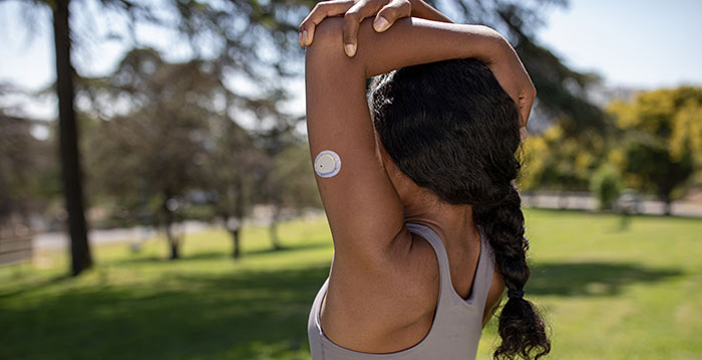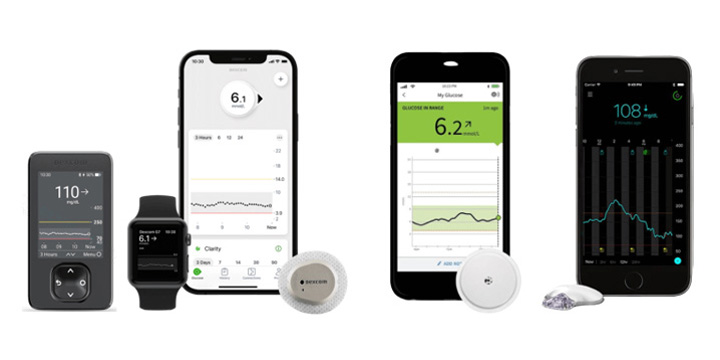
Why should you consider using a glucose sensor?
Living with diabetes comes with countless decisions every single day. For extra insights around these decisions, glucose sensors can be incredibly helpful. In addition to seeing your current glucose number, a glucose sensor will show you a graph of where your glucose has been, and trend arrows to give you an idea where your glucose is headed.
Why does this matter? Let’s consider an example where your blood glucose meter reads 6.8 mmol/L. Imagine you are about to drive, go to bed, or start exercising. How does that make you feel? Now imagine knowing that your glucose is 6.8 mmol/L with a downward trend arrow – this means your glucose levels are dropping. What might you do differently? What if you were 6.8 mmol/L with an upward trend arrow? Does that change your plans and/or feelings? It should!
Seeing these added insights around fluctuating glucose levels can feel like a game changer when it comes to daily diabetes management. In the moment you will see the impact of different food choices, varying activity levels, and your insulin doses. You may find yourself making positive changes to your daily behaviours in response to what you see and learn (and sharing with your healthcare team what you have learned about your own diabetes).
To ease your mind about where your glucose levels are at, you can choose to use automatic alerts that warn you when your glucose is too high or too low. Some sensors can even warn you when your glucose is predicted to be low soon or tell you when you are rising or falling quickly. Don’t like the idea of receiving alerts? You can also choose to leave many alerts on vibrate mode or even turned off. The alert options continue to evolve to fit a variety of personal preferences. Ultimately, it is up to YOU to choose which alert settings fit best into your life.
It’s no surprise that there is robust evidence to support the multiple proven health benefits of using a glucose sensor, including improvements in A1C, more time in range (for most people, this is the time spent between 3.9 – 10.0 mmol/L) and less time in the low glucose range. Just as importantly (or perhaps even more importantly to YOU), there are numerous proven quality-of-life benefits, including reduced diabetes distress, less fear of hypoglycemia, overall improved well-being and even improved sleep.
What should you think about when choosing a sensor?
Before we get into the details of the different sensor options available, think about your key goal for using a glucose sensor in the first place. Is it to prevent or limit low glucose events? Do you want to learn more about how your glucose is affected by food, exercise, and insulin or other medications? Are you trying to improve your A1C or time in target glucose range? Or do you simply like the convenience of using a glucose sensor rather than doing fingerstick blood glucose checks?
Fortunately, glucose sensors have continued to get easier to use, more comfortable, and more accurate. Anyone can be successful using them! Here are some key questions to ask yourself as you choose your sensor:
- How easy is the sensor to insert and use?
- Do I want to view my glucose readings on my smartphone/smartwatch?
- Will it be compatible with my smartphone? My smartwatch?
- Can I use a receiver/reader instead of a smartphone?
- What will the sensor look like and where on my body would I like to wear it? (for example, does it matter to me if others can see it?)
- Are there specific alert features that are important to me (for example, do I want alerts that can predict a low glucose before it happens)?
- How will the sensor fit into my everyday life (e.g., work, school, hobbies, activities, etc.)?
- Would I like to use it with a compatible insulin pump system to automate insulin delivery?
- What is the cost (per sensor, per month, per year)?
- Which system is covered by my provincial health plan and/or private insurance plan? (Be sure to keep checking back about updates to your coverage, as this continues to evolve over time.)
What are the key features of the currently available glucose sensors in Canada?
Not all sensors are the same. Consider the features in this glucose sensor comparison chart that are the most important to you. Take the time to make a careful decision about which sensor option will best fit into your life. After all, it is YOU who will be wearing it!
But which glucose sensor is the best?
Indeed, it can feel overwhelming to consider the various features of all the glucose sensor options. Keep in mind your key reasons for using it in the first place. The sensor that is best for you is the one that will fit into your everyday life and can help you meet your goals. Talk to your healthcare team about your goals and any concerns you may have. Most likely there’s a way to find a glucose sensor option that will work for you.




